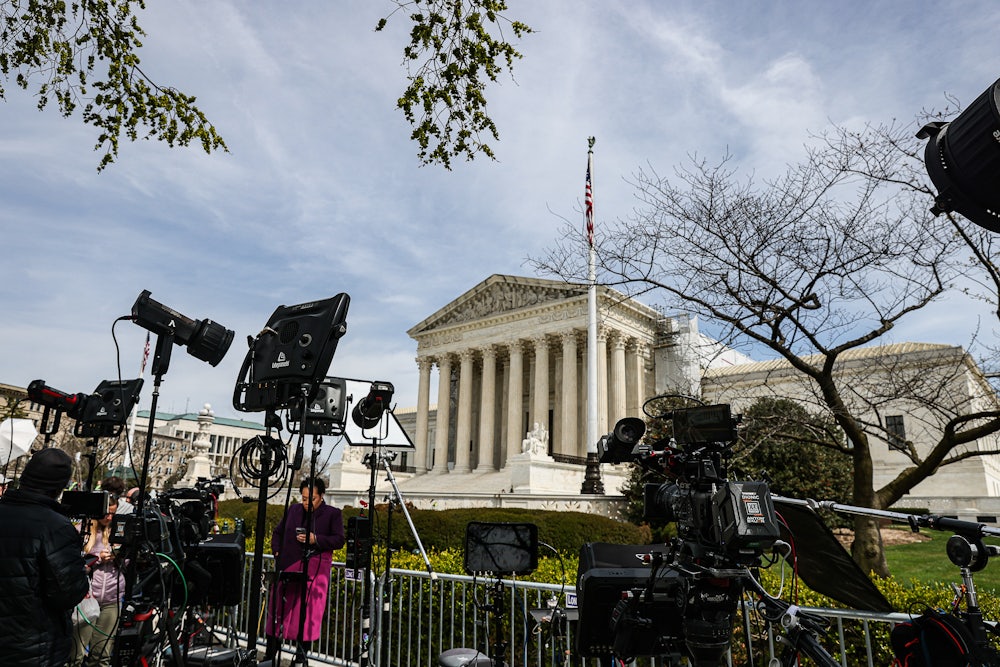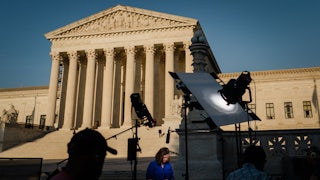The Supreme Court appeared unwilling on Tuesday to uphold a lower court ruling that would limit access to mifepristone, the nation’s most commonly used abortion drug. Even some of the court’s conservative members seemed skeptical that the anti-abortion plaintiffs had legal standing to challenge the Food and Drug Administration’s regulations of the drug.
“This case seems like a prime example of turning what could be a small lawsuit into a nationwide legislative assembly on an FDA rule or any other federal government action,” Justice Neil Gorsuch told attorney Erin Hawley, who argued for a group of anti-abortion medical professionals that sought to limit access to mifepristone. Chief Justice John Roberts also indicated in his questions that the lower courts’ rulings against the drug may have been too broad.
If the court’s decision reflects the course of oral arguments, it will be a legal defeat for the anti-abortion movement, but hardly a decisive one: With Roe now overturned, anti-abortion activists have sought to limit access to abortion in a variety of ways. The question now is whether the justices, in their decision, will indicate other means, like the Comstock Act or a different theory of standing, that anti-abortion activists could use to pursue their goals.
The case at hand, FDA v. Alliance for Hippocratic Medicine, is an oddity. American courts typically obey a command handed down by Article 3 of the Constitution: They only hear “cases and controversies.” American judges do not write advisory opinions, nor do they decide legal questions brought by two parties with nothing to gain or lose from them. A plaintiff must have standing—a legitimate reason to participate in a lawsuit—to get through the front door.
Tuesday’s case stretched the concept of standing to its limits. The plaintiffs are a coalition of anti-abortion medical professionals. In their 2022 lawsuit, they sought to overturn the FDA’s approval of mifepristone in 2000 by arguing that the agency erred in how it authorized it for public use. The Alliance for Hippocratic Medicine, or AHM, also argued, as a secondary matter, that the FDA’s subsequent rule changes were similarly flawed.
Before any court can even reach the merits of that argument, however, they have to address AHM’s ability to challenge it. Plaintiffs typically bring lawsuits when they suffer some sort of legal injury—personal, monetary, or so on—that the court can remedy. But the AHM members do not prescribe mifepristone. Some of them even refuse to do so based on conscience objections, which are protected by federal law.
Instead, the plaintiffs in this case argued that patients who take mifepristone might suffer adverse events, those patients might end up at the AHM members’ emergency rooms, and that treating them will pose all sorts of burdens to the members and their medical practices. “Ruling against [the doctors] on standing here would allow federal agencies to conscript non-regulated parties into violating their consciences and suffering other harm without judicial recourse,” Hawley said in her opening remarks for the justices.
This argument is a bit tenuous: Courts can hear cases involving hypothetical injuries, but they are usually ones that are imminent or near-certain. The AHM members’ purported legal injury was so hypothetical, and so rooted in random chance, that it might as well have been purely speculative.
The average federal judge might have nixed this lawsuit from the start for those reasons. But AHM ensured the case wouldn’t be heard by the average federal judge. They instead took advantage of federal court rules in Texas to all but guarantee that the case would be heard by Judge Matthew Kacsmaryk, who was appointed to the bench by President Donald Trump in 2019. Before becoming a judge, Kacsmaryk worked as deputy general counsel for First Liberty Institute, a conservative Christian legal organization where he had litigated against contraception-access laws.
In his ruling in April 2023, Kacsmaryk gave the plaintiffs practically everything they wanted. He overturned the FDA’s original approval of the drug in 2000 and ruled that subsequent rule changes were also unlawful. Kacsmaryk’s preliminary injunction, which he stayed pending appeal, would have had the practical effect of banning access to mifepristone throughout the United States.
The Fifth Circuit Court of Appeals, which itself is a staunchly conservative court, pared back some of Kacsmaryk’s ruling on review last year. The three-judge panel held that the original 2000 approval of mifepristone could not be overturned because of the statute of limitations and allowed the 2019 approval of a generic form of the drug to stand. The panel also upheld the post-2016 rule changes that had made it easier to obtain.
Abortion rights supporters already won a partial victory in this case when the Supreme Court agreed to hear it last December. The justices agreed to review part of the ruling that dealt with the post-2016 rules. But they declined to review the Fifth Circuit’s decision that left the 2000 approval intact. That meant, legally speaking, that any ruling the justices deliver in this case could only turn back the clock on mifepristone to 2016 at most, when the first of the recent rule changes went into effect.
Even prevailing on those grounds would still be a significant victory for anti-abortion activists, however. Mifepristone is the most widely used abortion drug in the nation, and medically induced abortions account for between 30 and 40 percent of abortions in the country. The new rules, promulgated in 2016 and 2021, allow the drug to be administered slightly later in pregnancy and eliminate a requirement for three in-person doctor visits before it can be prescribed.
Justice Samuel Alito, who wrote the court’s ruling to overturn Roe v. Wade two years ago, seemed eager to find a way to challenge the FDA’s rule changes. At times he seemed to be brainstorming about what a better plaintiff, with better standing, might look like. “Is there anybody who could challenge in court the lawfulness of what the FDA did here?” he asked Solicitor General Elizabeth Prelogar, who represented the federal government. “In this particular case, I think the answer is no,” she replied. “Well, that wasn’t my question,” he continued. “Is there anybody who can do that?”
What about state governments, Alito asked? No, Prelogar replied. “They’re asserting indirect injuries that would, if it provided a basis for standing, mean that states could always sue the federal government,” she explained. What if an emergency-room doctor receives a patient who is experiencing complications from taking mifepristone, that doctor is opposed to abortion and is the only doctor on staff at that moment, and the doctor’s only option is to “abort a viable fetus,” Alito asked?
Prelogar noted that doctors have federal conscience protections and that Alito’s scenario was extremely unlikely. “We think that that situation has never come to pass,” she explained. “[The plaintiffs] haven’t identified any incident in more than 20 years that mifepristone has been available on the market that resembles that kind of hypothetical situation. And so, yes, our view would be it’s unduly speculative.”
What about a patient who experienced adverse consequences from taking mifepristone, Alito asked? Could they sue the FDA for damages? Prelogar said that the suit would probably be barred by sovereign immunity, a doctrine that generally means the government can’t be sued without its permission.
Eventually Alito got to his real point: fishing for a viable plaintiff who could challenge mifepristone. “Is there anybody who can sue and get a judicial ruling on whether what FDA did was lawful?” he finally asked. “And maybe what they did was perfectly lawful, but shouldn’t somebody be able to challenge that in court? Who, in your view? Who would have standing to bring that suit?” Prelogar noted that the court has often held that just because someone doesn’t have standing to challenge something doesn’t mean Article 3 should be ignored.
“OK. I understand that,” Alito replied, before tipping his hand. “And Article 3 is important. So your argument is that it doesn’t matter if FDA flagrantly violated the law, it didn’t do what it should have done, endangered the health of women, it’s just too bad nobody can sue in court? There’s no remedy? The American people have no remedy for that?”
It fell to Prelogar to note that the FDA monitors unsafe drugs all the time, rebutting Alito’s implicit claim that the agency would simply allow an unsafe drug to stay on the market. (While Prelogar did not mention it, Congress could theoretically step in and ban a drug itself if the FDA somehow allowed one to stay on the market despite safety issues.) None of the other justices appeared to embrace Alito’s suggestion that the justices could step in anyway.
Instead, some of the court’s conservative members asked questions that suggested the plaintiffs might have other remedies if they suffered actual injuries. Justice Amy Coney Barrett extracted assurances from Prelogar that federal conscience protections could be invoked by anti-abortion doctors in hypotheticals like Alito’s. “The federal government has never taken the position that EMTALA would override an individual doctor’s conscience objections,” Prelogar confirmed, referring to the Emergency Medical Treatment and Active Labor Act, which regulates hospital emergency rooms.
“Just to confirm on the standing issue, under federal law, no doctors can be forced against their conscience to perform or assist in an abortion, correct?” Justice Brett Kavanaugh asked, hammering the point home. “Yes,” Prelogar replied. “We think that federal conscience protections provide broad coverage here.”
Those questions, combined with Gorsuch’s apparent dissatisfaction with the case’s broad scope, appeared to doom it. But some of the justices appeared interested in finding future avenues of attack. Alito asked Prelogar at one point if the FDA should have “at least considered the application of 18 U.S.C. 1461,” an archaic provision in federal law that comes from the Comstock Act of 1873. That law bans the distribution of contraceptives, “lewd” writings, and anything that could be used to carry out an abortion through the mail.
Federal courts whittled down the law’s scope throughout the twentieth century on multiple grounds, and by the 1930s, the federal government effectively stopped enforcing it. As my colleague Melissa Gira Grant has reported, however, conservative legal groups have sought to revive the Comstock Act as a potential avenue for imposing a nationwide abortion ban. Alito appeared sympathetic to those aims at oral arguments on Tuesday.
“This is a prominent provision,” he claimed while questioning Prelogar. “It’s not some obscure subsection of a complicated obscure law. [The FDA] knew about it. Everybody in this field knew about it.” Justice Clarence Thomas also suggested that it might not be defunct. “How do you respond to an argument that mailing your product and advertising it would violate the Comstock Act?” he asked Jessica Ellsworth, a lawyer representing mifepristone distributor Danco Laboratories.
The other justices did not press the Comstock Act question, however, and instead seemed more interested in the case’s viability on standing grounds. That likely indicates that the court is on track to dismiss the case when it hands down a ruling later this term. That two justices appear willing to consider the moribund 1873 law as a viable means to restrict abortion in 2024 will likely keep abortion rights activists from claiming total victory.
Even if the court’s conservatives recognize this case’s procedural flaws, they might use the opportunity to suggest a different way forward to restrict abortion access nationwide. For now, the ball remains firmly in the anti-abortion movement’s court.








